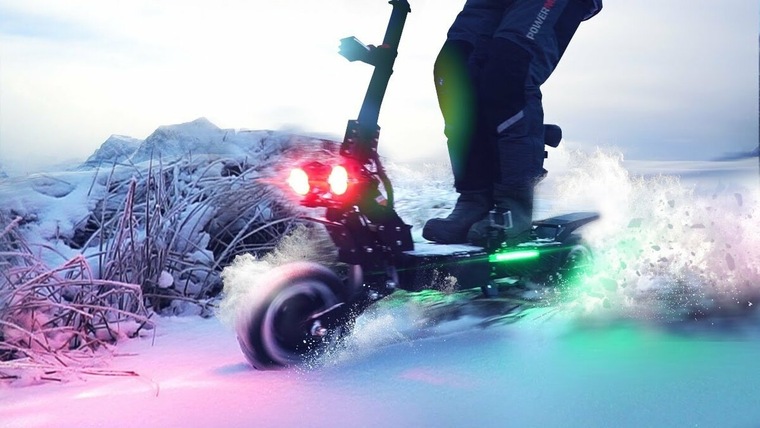My name is Phillip Gray and I love going outdoors riding on skates and scooters. I work as a graphic designer and I love creativity. This is why I appreciate the different creative scooter’s designs. I’ve been riding on kick scooters ever since I was 5 and one of my early scooters had grown-up together with me.
Is it possible to ride a scooter during winter
As a general rule, we prefer not to recommend the electric scooter, just like other EDMMs, to travel in winter because it is not designed to ride in extreme conditions such as heavy rain or snow. However, given the health crisis, kick scooters may be the best way to get around in some situations.
Yes, anyone can ride a scooter during winter provided safety precautions are strictly observed.
Like any other vehicles motorized or not, accidents can happen when the road is slippery. If cars with bigger tires slide, so manual rides like bicycles and scooters. They have small tires so extra care is needed when riding during winter.
To ensure your safety and survival of your vehicle this winter, here are our
10 tips for winter riding.
1. Slow down and turn more carefully, especially on slippery surfaces
It sounds relatively logical, but it’s important to remember! Drive even more carefully when the weather is not there. Start by slowing down your pace. Under certain conditions, the pavement can be so slippery that even when stopped you may lose your balance.
Note that the cooler and denser the snow, the more slippery it is. Don’t try to venture there!
Driving fast on all these types of surfaces greatly increases your risk of falling. In addition to driving slower, you also need to turn slower than usual, as, for a car, it is much safer not to change direction abruptly.
2. Deflate your tires a little
When winter arrives, you should deflate the tires a little (if your device has rubber tires). Try to deflate them by about 10% at the beginning and see if you feel comfortable. If you slip a lot more, you can deflate a little more.
The less inflated a tire is, the more friction it creates with the surface, which allows it to brake better. As soon as the snow melts and winter is over, you can re-inflate your tires to the normal level.
It is not advisable to ride on a machine with polyurethane wheels during winder as this is too slippery. The plastic has zero traction.

3. Replace your tires
Preparing your tires for winter can make all the difference.
Be aware that air-inflated tires are always more efficient than solid tires, for the winter anyway. If your tires are too smooth, change them! You risk aquaplaning if they are too worn out.
4. Anticipate your braking
Try to anticipate your braking on a slippery surface, too hard braking will cause a fall for sure, always prefer the rear brake!
5. Take care of your battery, especially during the winter (for electric scooters)
As mentioned above, electric rides are not advisable to use but when it is not avoidable, this tip will do.
During the winter, your battery is much more vulnerable. The proof is that scooters use more energy to travel the same distance when it’s cold!
Do not load your machine immediately after riding in the cold, it recharges ideally at room temperature. When recharged in rooms that are too hot or too cold, it will tend to recharge less quickly and degrade. So when you get home after a winter ride, let your machine warm up for about ten minutes to room temperature before you start charging. Also, avoid recharging in your garage!

6. Don’t completely drain your battery
This advice also applies in summer, but given that batteries discharge faster in winter, it’s important to remember this! Especially for lithium-ion batteries, often used for scooters, try as much as possible to always keep some battery. Emptying it completely regularly will drastically reduce its lifespan.
7. Waterproof your electric scooter
Despite the electric scooters that say they are “waterproof”, you are never safe from a nasty surprise. Some small manipulations reduce the chances of damaging your mount:
- Put silicone at the junction of the controller’s two cases
- Place toric seals around unsealed screws and on holes with wires or cables
- Add extra protection or silicone to the power button, LED screen, and accelerator
- Extend the fender
8. Clean your scooter!
One of the many advantages of the scooters is that it requires almost no maintenance. However, in winter it asks for a little more than usual!
Water on metal parts can cause rust. This can be particularly serious if it enters the battery case. In addition, salt that is sprayed on roads in snowy weather accelerates this corrosion phenomenon.
No need to completely clean your scooter after each use, but do so when it looks dirty. A microfiber cloth will do the trick (no need to specify not to use its garden hose!)
9. Dress warmly and protect yourself from the wind
Cold, wind, snow, and rain will affect your driving. Dress as warmly as possible while staying comfortable! Glasses can be useful in times of rough weather as squinting while driving can be extremely dangerous. Gloves are also essential when it’s very cold: on electric scooters, you brake and accelerate with your fingers so it’s very important that they stay mobile!
When it comes to shoes, opt for waterproof, high shoes instead of sneakers. They will keep your feet dry and protect you from splashing.

10. Put as much safety equipment on you as possible
You’ll never be reminded as much as you do in winter: wear as much safety equipment as possible! The helmet being the bare minimum, we also recommend elbow pads and knee pads, timeless from all autumn-winter trends! The chances of slipping are much higher and your elbows and knees will be the first shock points.
Here are our 3 small bonus recommendations for the different climate situations you may encounter
- When you ride in the rain: It’s a bit of a coin, in principle (depending on your gear) you should be able to finish your journey but you risk short-circuiting your scooter
- When you ride on snow: It is possible to ride on snow (packed, not in powder either) however you have to be very careful in the ice zones and the principle of the pile or face remains the same as for the rain. You won’t be driving safely. Choose sledding!
- When riding on the ice: Avoid riding on the ice at all costs, if there’s one thing scooters can’t stand at all, it’s ice. You may be less likely to damage your car but much more likely to injure yourself.
Stay tuned this winter on the road!






